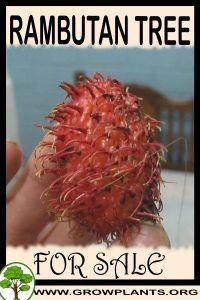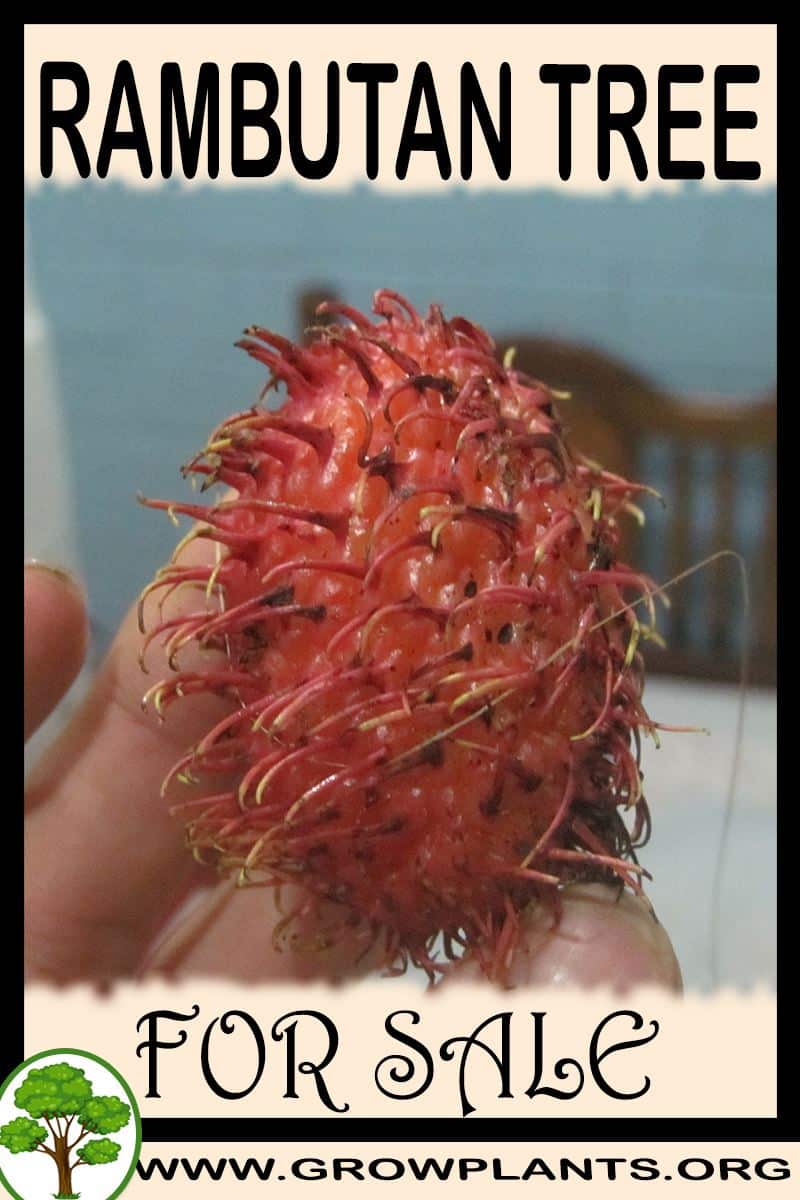
Rambutan tree for sale – Easy plant to grow with edible fruits and seeds, planting season all year, better to buy plant, grafted tree male and female plant or another option to start from seeds yet more challenging.
Rambutan tree – information before buying:
Growing information: perennial plant, growing hardiness zone: 13+, water needed – big amount, light conditions – full sun to partial shade, height: 5-10 m, 15-30 feet.
Blooming in the spring to summer that appear in white color.
Fruits harvesting in the autumn to winter in ovate shaped fruits that appear in white-yellowish color.
Alternative names: Nephelium lappaceum, Hairy lychee
Rambutan tree for sale
Varieties – Rambutan is a cross-pollinated crop. Common rambutan is red. Varieties yellow, orange and green are less common. Selection and vegetative propagation lead to selected clones. The current popular variety in Malaysia is R191. Common varieties are R9 (red orange) R134 (orange red), R156 (yellow variety), R162, R167 (red orange)., R170, R191 and R193. Varieties Binjai, Chanthaburi, Garuda, Lebak Bulus, Maharlika, Rapia (red orange), Sibangkok, Seematjan, Sectangkooweh, Seekonto, Seelengkeng and Seenjonja are also popular varieties.
Uses – Rambutan has been used in Malaysia and Indonesia in treatments to treat diabetes or high blood pressure. Rich in nutrients, this fruit also has other health benefits. Due to the presence of carbohydrates and proteins, this fruit helps increase energy. Vitamin C promotes the absorption of iron, copper and other minerals. This vitamin also helps protect the body from free radicals. Thanks to the calcium contained in the fruit, rambutans are also ideal for strengthening teeth and bones. Rich in iron, rambutan helps fight against anemia and limits the feeling of fatigue. Rambutans contain fibers, an interesting point to limit the feeling of hunger. Consuming tea made from the leaves of this plant is effective in losing weight. This is due to the following properties (the phenols it contains help detoxify the stomach and intestines, the tannins help kill parasites and bacteria present in the intestines.)
Location – Rambutan is necessarily planted in pots because of its non-rusticity. In summer, the plant can be taken outside, the rest of the year it must be grown in a greenhouse. Cultivation inside the house is impossible, the tree would perish and die very quickly. The place must be sheltered from the winds.
Soil – Clay or sandy soil with a pH acidic (4 to 6)
Temperature – Between 18 and 25°C (64 to 77°F)
Watering – frequent watering each 3 days
Fertilization – each 2 months
Propagation – Rambutan is propagated by sowing, layering or grafting. When sowing, use very fresh seeds. In this case, germination is very rapid and generally occurs in 2 to 3 weeks. Grafting is difficult to do so used for propagation of delicate varieties.
Pruning – In pots, rambutan cannot be pruned.
Harvesting – When the crop has been sown, you have to wait between 5 and 6 years for fruit production. From 8 years old, rambutan is mature and can produce around 200 kg of fruit each year. Time for harvesting is really short. Harvest when the fruits are matured and color change is complete. After harvesting don’t expose the fruit to the sun.
Pest and diseases – Powdery mildew appears as a white color on the fruit. Mealybugs, mites, thrips and aunt damage the skin of the fruit. Rambutans are also hosts of different species of fruit flies (Ceratitis capitata and Bactrocera dorsalis)
Categories
| growing |
|
|---|

